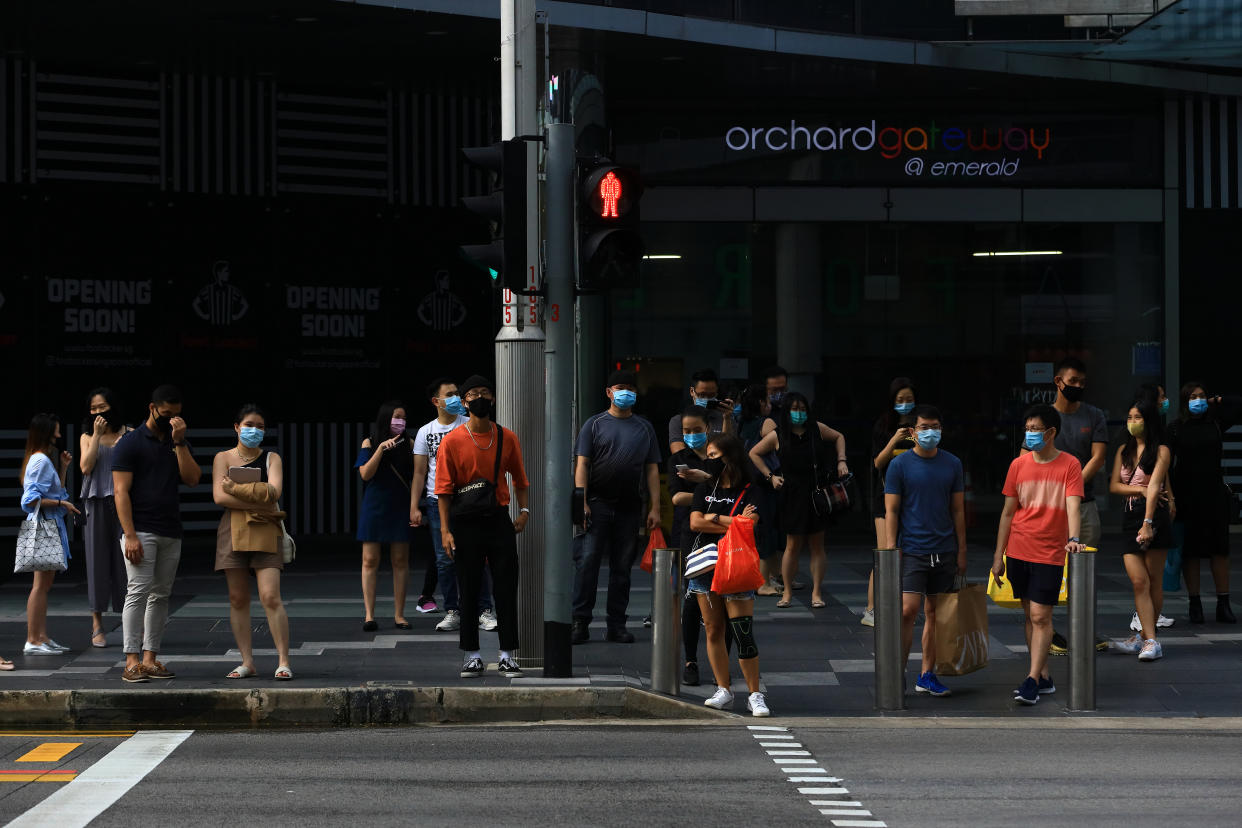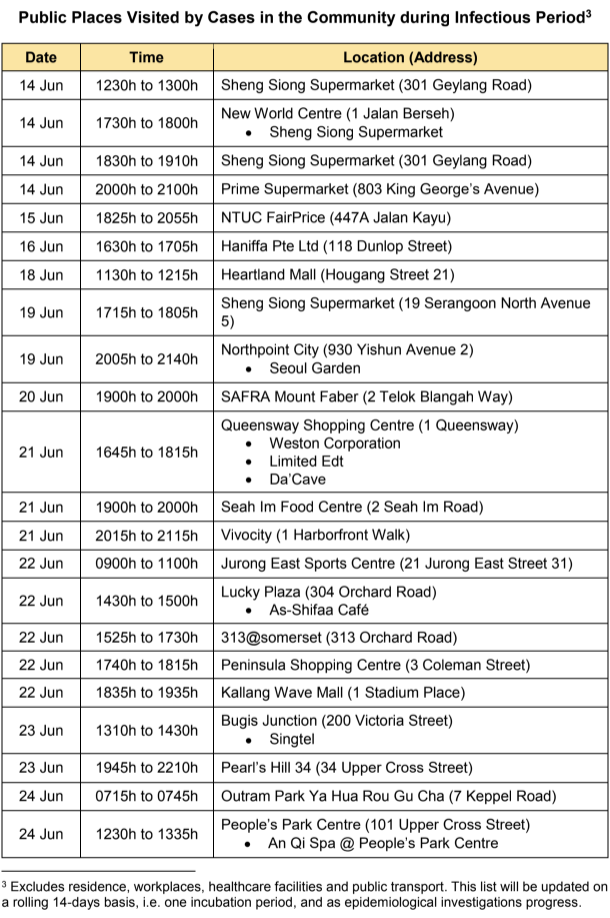5 Singaporeans among 291 new COVID-19 cases, total at 43,246

SINGAPORE — The Ministry of Health (MOH) reported 291 new COVID-19 cases in Singapore as of Saturday (27 June) noon, including five Singaporeans, bringing the total to 43,246.
There were 11 cases in the community comprising five Singaporeans and six foreigners working here.
Amongst the five Singaporean cases, three cases are from a family cluster: a 34-year-old woman, a five-year-old boy and a 35-year-old man of cases 43261, 43262 and 43263 respectively. They were contacts of a previously confirmed case who had been tested as he works at a dormitory.
All three cases had already been quarantined, and were swabbed during quarantine to verify their status. Another case, a 66-year-old Singaporean man, case 43278, was detected due to proactive surveillance of persons working at dormitories, even though he is asymptomatic. Epidemiological investigations are ongoing for the remaining 63-year-old Singaporean woman, case 43099.
Amongst the six work pass/work permit holders, a Myanmar female national and an Indonesian female national, both 37, and cases 43100 and 43146 respectively, had been identified as contacts of previously confirmed cases, and had already been quarantined earlier. They were swabbed during quarantine to verify their status.
The remaining four cases, a 38-year-old male Indian national, a 43-year-old male Indian national, a 35-year-old male Bangladeshi national and a 39-year-old male Indian national, of cases 43228, 43229, 43264 and 43280 respectively, were detected as part of screening of workers in essential services.
Overall, the number of new cases in the community has increased, from an average of four cases per day in the week before, to an average of six per day in the past week. The number of unlinked cases in the community has also increased, from an average of two cases per day in the week before, to an average of three per day in the past week.
With more activities resuming in Phase 2, the MOH said it is critical to exercise continuous caution to keep the number of new cases under control.
“All of us must adhere to safe management principles. Irresponsible behaviour that disregards the spirit of the rule to limit social gatherings to not more than five persons endangers others, and may lead to the formation of large infection clusters. We urge everyone to continue to exercise personal responsibility and not put the community at risk,” the MOH said.
The MOH added that it takes a serious view of such breaches and will not hesitate to take actions against individuals who breach the rules.
On Friday, the MOH said one of the new cases had met a large group of social contacts for sports and social activities. “Such behaviour increases the risk of transmission and has resulted in his contacts being quarantined...We advise the public to abide by the spirit of the rule to limit social gatherings to not more than five persons,” the MOH said then.
MOH said it has completed a round of surveillance tests for non-residential community staff including staff from kidney dialysis centres, home care and senior care centres. Out of more than 5,700 staff tested, all were tested negative with the exception of one staff who had been announced on 26 June.
Dormitories cleared of COVID-19
The Ministry of Manpower (MOM) said on Tuesday that 31 more dorms have been cleared of COVID-19: 27 factory-converted dormitories and four construction temporary quarters.
Four blocks for recovered workers in three purpose-built dorms have also been cleared, the MOM added.
This takes the total number to 163 dorms and 18 blocks for recovered workers in 11 purpose-built dorms cleared of COVID-19.
As of 22 June, about 79,000 foreign workers have been cleared of COVID-19, including those residing in government-provided accommodation facilities, said the MOM. A forecast of dormitories and blocks to be cleared from now till August onwards has been published on the ministry’s website.
On Saturday, there was no new place or date entry added to the MOH list of public venues visited by infectious community cases for over 30 minutes.
First published on 25 May, the list – which excludes residences, workplaces, healthcare facilities, and public transport – will be updated on a rolling 14-day basis or one incubation period.


86% have fully recovered
With 338 more patients discharged from hospitals or community isolation facilities on Saturday, 37,163 cases – some 86 per cent of the total tally – have fully recovered from the infection.
Most of the 174 hospitalised cases are stable or improving, while at least one is in critical condition in the intensive care unit.
A total of 5,883 patients with mild symptoms or are clinically well but still test positive are isolated and cared for at community facilities.
Apart from 26 patients who have died from COVID-19 complications, 13 others who tested positive for the virus were determined to have died from unrelated causes, including three whose deaths were attributed to a heart attack and another four whose deaths were attributed to coronary heart disease. Of the latter group, a 27-year-old male Bangladeshi national who had COVID-19 infection died on Thursday after he fell from height.
“Only cases where the attending doctor or pathologist attributes the primary or underlying cause of death as due to COVID-19 infection will be added to the COVID-19 death count,” said the MOH in previous press releases, adding that the method of assessment is consistent with international practices for classifying deaths.
As of 15 June, the ministry has conducted 576,189 swab tests, of which 340,894 were done on unique individuals. This translates to around 101,100 swabs conducted per 1 million total population, and about 59,800 unique individuals swabbed per 1 million total population.
Singapore entered Phase 2 of its reopening – with various safe distancing measures still in place – on 19 June. This phase is expected to last up to six months or longer, according to authorities.
Singapore’s General Election will take place on 10 July during this phase.
Stay in the know on-the-go: Join Yahoo Singapore's Telegram channel at http://t.me/YahooSingapore
More Singapore stories:
GE2020: PAP's manifesto focuses on 'keeping Singapore going'
GE2020: Deputy Speaker Charles Chong among 20-odd PAP MPs to retire
GE2020: PAP candidate Ivan Lim responds to online criticism, pledges to 'stay the course'
GE2020: Elections Department receives 226 applications for political donation certificate



